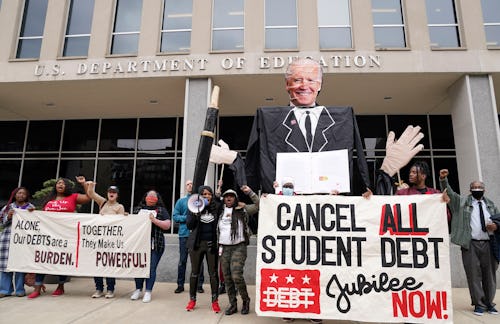Turns out the government forgot to tell people their student loans could be forgiven
A new watchdog report found the Department of Education is really, really bad at tracking student loans.

For months — years now, really— activists and lawmakers alike have been screaming at the top of their lungs for the government to do an extremely obvious, unambiguously good thing, and codify the White House’s pandemic-fueled series of federal student loan deferrals into an actual permanent cancelation.
To date, the Biden administration has resisted the calls to relieve the nearly $2 trillion worth of student loan debt in this country, choosing instead to implement a rolling series of limited, conditional deferments and very specific forgiveness plans for select groups under certain circumstances — the effect of which has been to accentuate just how easy and undisruptive it would be to just cancel student debt entirely.
Nevertheless, if something can be done easily and effectively, leave it to the labyrinthine bureaucracy of the federal government to royally screw it up. Which, incidentally, is exactly what seems to have happened, according to a just-released Government Accountability Office report showing thousands of loans filed under the Income-Driven Repayment plan could have been eligible for full forgiveness since the fall of 2020, but only a handful actually have been forgiven. Why? Because, as the GAO investigation found, the government is evidently really, really bad at tracking this sort of stuff.
“GAO found that about 7,700 loans in repayment (about 11% of loans analyzed) could be potentially eligible for IDR forgiveness,” a topline summary of the report wryly notes. “[The Department of] Education's repayment data do not provide enough information to definitively determine why these loans — totaling about $49 million in outstanding debt — had not been forgiven as of Sept. 1, 2020. Education officials said data limitations make it difficult to track some qualifying payments and older loans are at higher risk for payment tracking errors.”
“Until [the Department of Education] takes steps to address such errors, some borrowers may not receive the IDR forgiveness they are entitled,” the report concludes.
Elsewhere in the report, the GAO determined that the main roadblock in forgiving these types of loans is that the government is simply doing a bad job tracking, clarifying, and notifying the debt holders themselves of where they stand within the program.
Put another way: The government has created a latticework of student loan programs so complex and dynamic that it can’t actually keep good track of its own project.
Of course, an easy solution to all this would simply be to cancel student loan debt entirely. But it seems as if the Biden administration is content to just kick that particular can down the road, for now.